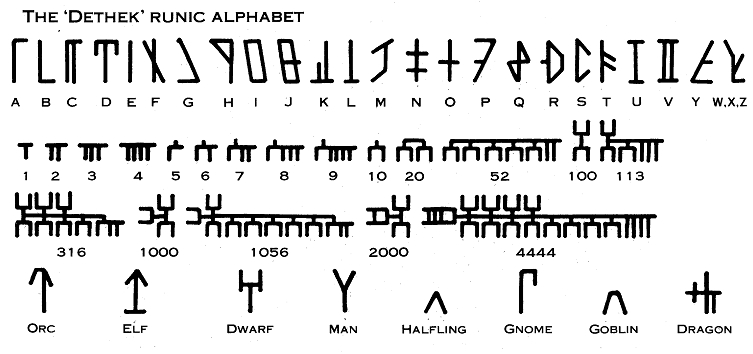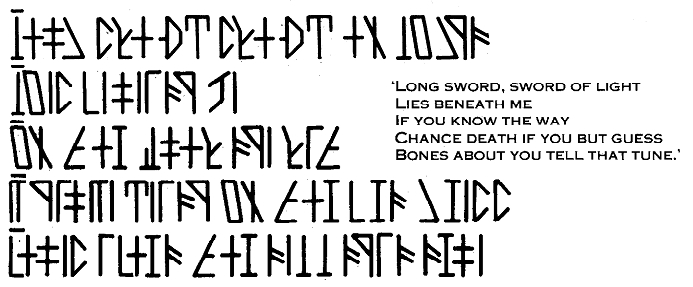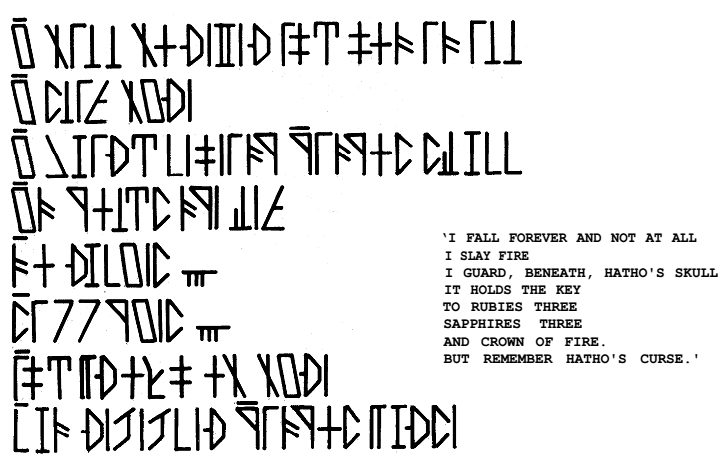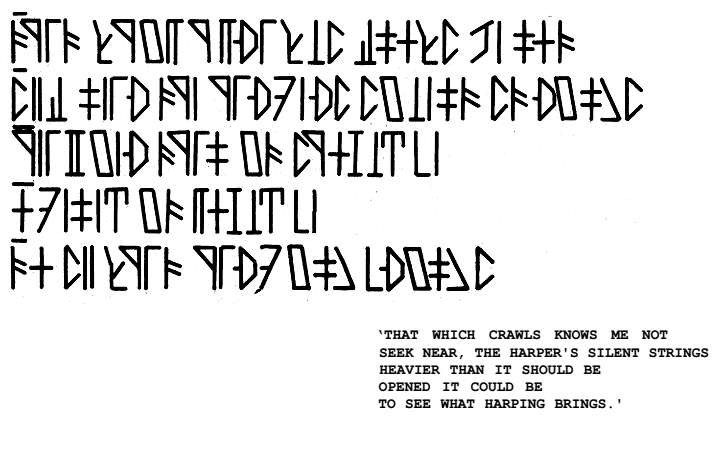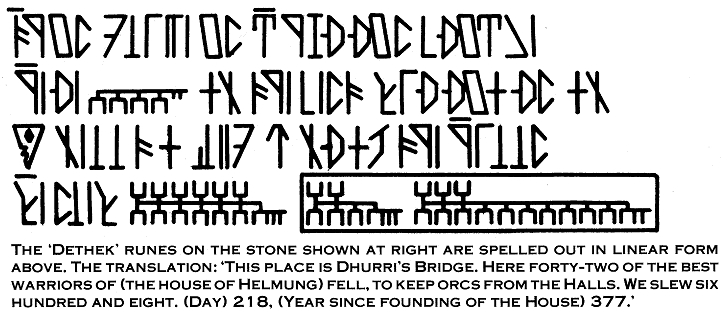

| - | - | Runic Inscriptions | - | - |
| Dragon | - | Races | Best of Dragon, Vol. IV | Dragon 69 |
One night Elminster and I were sharing what fantasy writer Lin Carter
calls a
“round of converse” (the sage has acquired a weakness for pina coladas,
a
beverage unknown in the Realms from
whence he comes), and our talk turned
to the dwarves.
Elminster thought the picture of the
Hill Dwarf in the AD&D™
Monster Cards
very striking. While he was admiring it,
your wily editor asked if he knew of any
written dwarvish records: tomes of lore,
for instance, and, ahem, magic. Elminster chuckled and reached into
one of
the many pockets in his voluminous
robes (yes, I know he looks odd, but the
neighbors think I’m strange anyway),
coming out with his pipe and pouch —
and a stone, which he handed to me.
“Dwarves seldom write on that which
can perish,” Elminster said, lighting up.
“Rarely, they stamp or enscribe runes on
metal sheets and bind these together to
make books, but stone is the usual medium: stone walls in caverns,
stone buildings, pillars or standing stones — even
cairns. Most often, they write on tablets
— ‘runestones,’ as we call them in the
Common Tongue.”
The stone I held was flat and diamondshaped, about an inch thick, and
of some
very hard rock I did not recognize. It was
deep green in color, polished smooth,
but it was not, Elminster assured me, any
sort of jade. The face of the stone was
inscribed with runes in a ring or spiral
around the edge (see illustration), and at
the center bore a picture. Some runestones have pictures in relief,
and are
used as seals or can be pressed into wet
mud to serve as temporary trail markers
underground.
To a dwarf, all runestones bear some
sort of message. Most are covered with
runic script; Elminster knows of three
such scripts. One of them, known as
“Dethek,” translates directly into Common, and all of the stones he
showed me
that night and subsequently were in this
script. The runes of this script are simple
and made up of straight lines, for ease in
since the sound it makes in a word can
be expressed by an “s” or “k” character.
Players and DMs have to consider
what sorts of materials and techniques
are available for scribing or writing the
runes onto a surface. Geography will
have an effect on available materials, just
as it did with the Germanic tribes. Tree
limbs and large rocks, for instance, were
in abundance where the Germanic tribes
lived. In a fantasy environment that contains large trees and rocks,
these would
be obvious and often-used surfaces for
carving. But in a world devoid of trees or
rocks (a distinct possibility in a fantasy
milieu), choices for a carving medium
would be restricted to other suitable
materials that are available.
Runescan be carved on manufactured
items — rings, weapons, gauntlets, and
so forth. Even a world that doesn’t contain an abundance of suitable
raw materials will have weapons, magic items,
and other things that can be inscribed.
Runes can be written (applied upon a
surface instead of being etched into it)
on almost any material that will accept
ink, pigment, charcoal, or other writing
mediums. Parchment, animal hide, or —
for the very lavish — vellum (calf’s hide
finely tanned and scraped) will hold ink
from a quill or pigment from a brush.
Historically, certain techniques were
used in the configuration of rune characters in or on a surface. On
free-standing
stones (rune-stones), the characters
were often carved between parallel borders in the form of a winding
“snake”
design which served to embellish the
work and make the stone more attractive. A less artistic method of
carving was
to simply put down the characters in
“rune-rows,” set off from one another by
straight horizontal lines, often spaced so
that the tops and bottoms of the rune
characters touched the lines.
Words were not usually set off by spaces between them; rather, one
would be
separated from the next by a dot or a
small “x.” Words were also distinguished
by painting them in different colors, but
if the coloring washed away or was worn
away, the message could become rather
cryptic. According to many legends (including Egil’s Saga), the magic
of runes
would not work unless the writing was
smeared with blood.
As with any other subject that has a
foundation in history, the concept of
runes can be adapted by players and
DMs for use in a fantasy role-playing
game, without necessarily remaining totally faithful to the way runes
were used
in history. Perhaps a runic alphabet will
be developed into the most widely used
form of communication in a fantasy
world. Or, perhaps the “art” of scribing
runes will be only partially developed
and known only to a select few. Any system is appropriate, as long
as it’s logical
and as long as it “fits” in the world for
which it was designed.
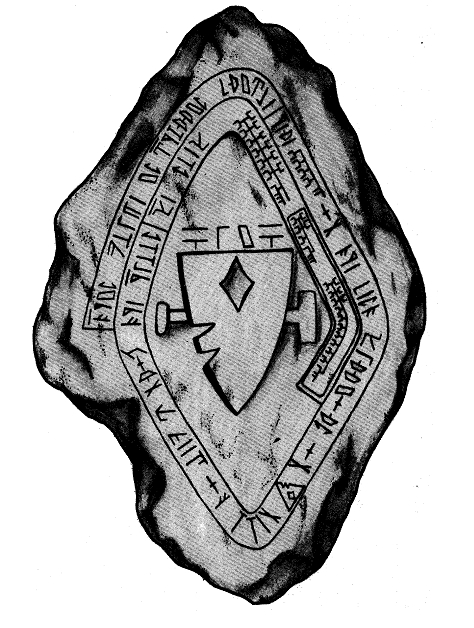
cutting them into stone. No punctuation
can be shown in Dethek, but sentences
are usually separated by cross-lines in
the frames which hold the lines of script;
words are separated by spaces; and capital letters have a line drawn
above them.
Numbers which are enclosed in boxes
(within the frames) are dates, day preceding year by convention. There
are
collective symbols or characters for
identifying peoples (clans or tribes) or
races. If any runes are painted, names of
beings and places are commonly picked
out in red, while the rest of the text is
colored black or left as unadorned
grooves.
Runestones are commonly read from
the outer edge toward the center; the
writing forms a spiral which encloses a
central picture. In the case of the stone
illustrated here (Elminster said this stone
came from a place now destroyed), the
crude central picture identifies the writer
as a warrior (the hammer) of the House
of Helmung, now thought to be extinct.
(His name, “Nain,” is written above the
shield of Helmung, as is the custom. A
dwarf of some importance would place
his personal rune here.)
Runestones telling a legend or tale of
heroism usually have a picture of the
climactic scene described in the text;
grave markers or histories usually reproduce the face or mark of the
dwarves
described. The central symbol may also
be a commonly understood symbol (e.g.,
a symbol of a foot for a trail marker, or an
inverted helm to denote safe drinking
water), or sometimes nothing more than
simple decoration.
Runestones serve as genealogies and
family burial markers, Elminster told me,
and to record tales of great events and
deeds of valor. They may be inventories
of the wealth of a band, or private messages which would be meaningless
to
all
but a few individuals.
One stone was found in a labyrinth of
dwarven caverns cut into a mountain
range, serving as a very plain warning
— to those who knew the script — of a pit
trap just beyond. Another, somewhere in
the same abandoned dwarf-halls, is reputed to hold a clue to the whereabouts
of the Hammer of Thunderbolts once
borne in the Battle of the Drowning of
Lornak.
“But you,” Elminster said, looking innocently up at the smoke rings
slowly
rising in the evening sky above his rocking chair, “will as usual be
most interested in treasure.” I made him another
drink, and in silence we watched the fireflies play around the garden
fountains. I
waited, and finally he spoke. “Apart from
those stones that are treasure maps —
usually directions hidden in those cryptic verses people write when
they think
they’re being clever — a few stones are
themselves magical, or adorned with
gems.”
Later meetings with Elminster yielded
three examples of “treasure-map” stones
(the text from which is reproduced here),
and two examples of magical stones: a
record in the Book of Passing Years that
mentions a runestone that functions as
an Arrow of Direction, and almost forty
references in the folk tales and ballads of
the northern Realms to runestones that
spoke (via a magic mouth spell) when
certain persons were near, or when certain words — sometimes nothing
more
than nonsense words inscribed upon the
stone itself, to be read aloud — were said
over it.
Some non-magical runestones contain
warnings, or poetry, but most often their
songs are treasure-verses. A few such
verses are recorded here; Elminster assures me that as far as he knows,
no one
has yet found the treasures hinted at in
these examples. All of them await any
adventuring band that is strong and
brave, of keen wits and good luck. “That’s
why,” he added dryly, “they haven’t been
found yet.”
